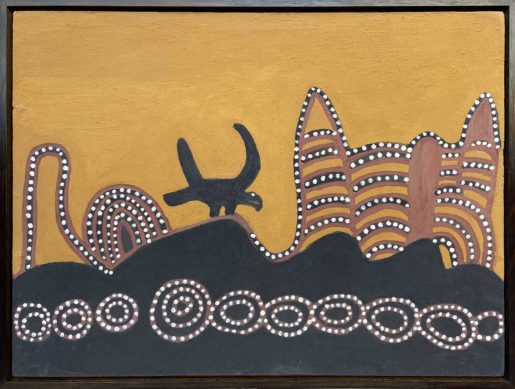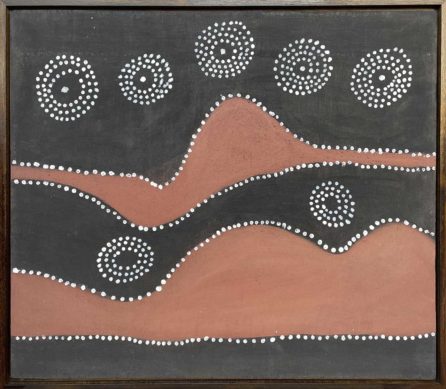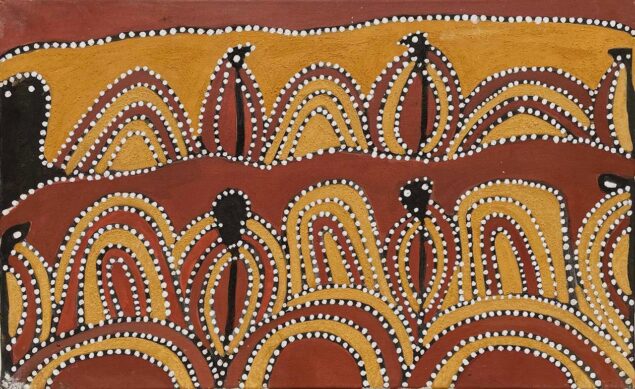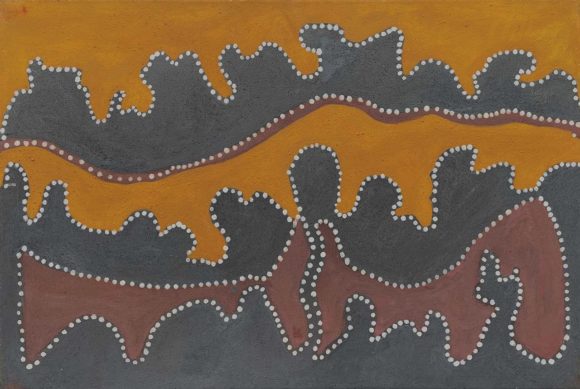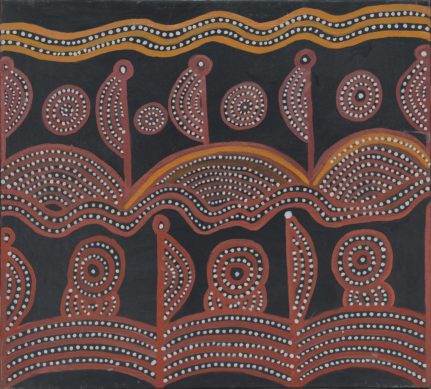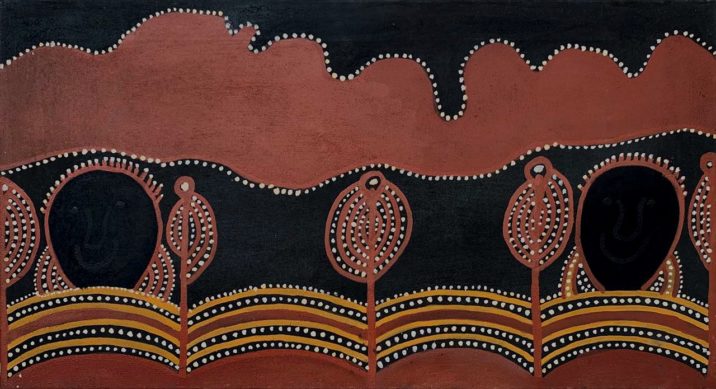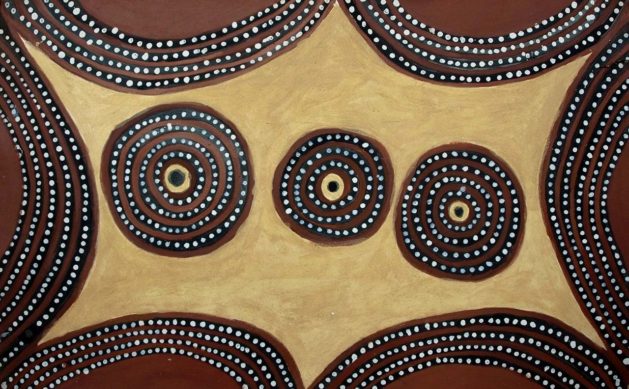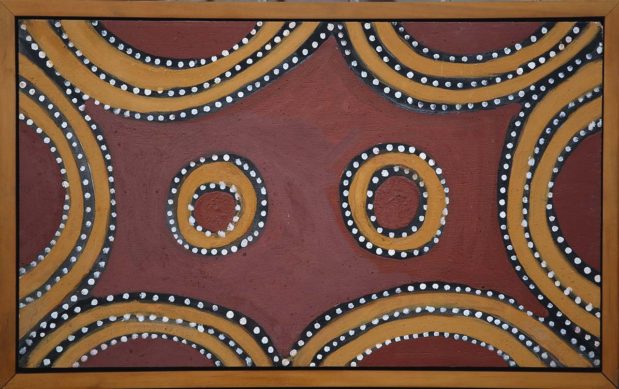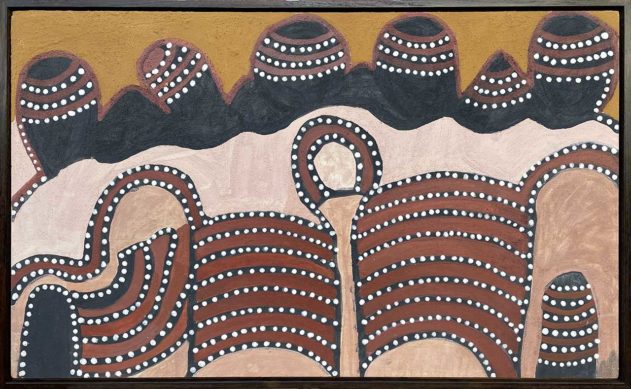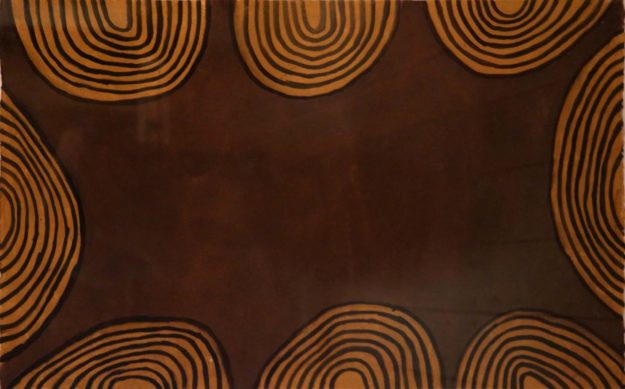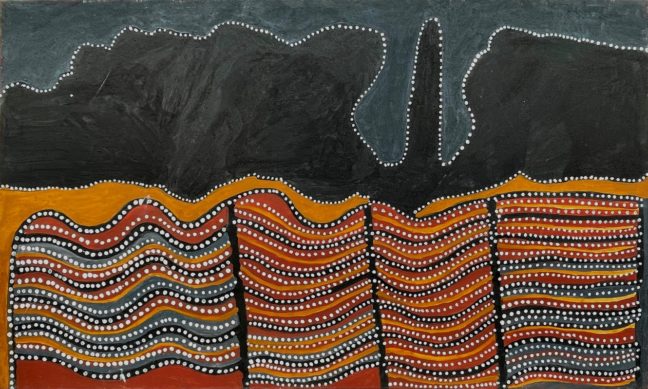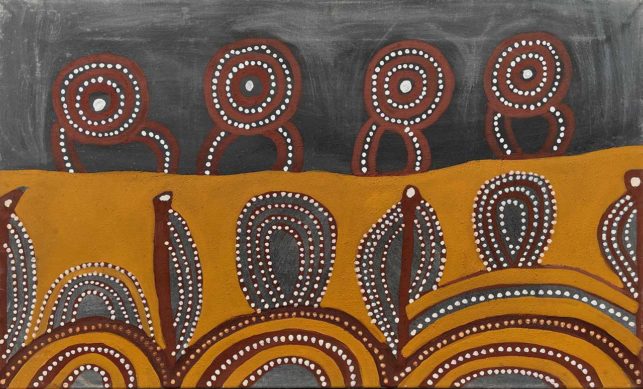Jack Britten Paintings
Jack Britten - Senior Warmun artist, painted Purnululu, Bungle Bungles in the East Kimberley.

Artist Jack Britten at Japingka Gallery
About Jack Britten
Date of Birth
c. 1921 – 2001
Place of Birth
Tickalara Station, Turkey Creek, WA
Language
Kitja
Community
Frog Hollow, Warmun, Western Australia
Family History
Jack Britten (c1921- 2001) was a senior Gija Lawman who painted for about 20 years. He was born in the hills to the north of Alice Downs, at Garnawarranginy, where his family had gone to hide from white people. In his latter years he lived at Wurreranginy (Frog Hollow), his mother’s birthplace, about 35 km south of Warmun (Turkey Creek). Wurreranginy is a small outstation of which he was the chairman.
Jack Britten’s country is an area south of Warmun stretching from where he lived at Frog Hollow, east to the Bungle Bungles, then south to the former Hann Springs and Tickelara cattle stations, and on to the upper reaches of the Ord River and the hilly terrain of Mabel Downs. As a boy Jack Britten roamed these places with his family, hunting and gathering bush tucker. In his work Jack Britten portrays some of the special sites in his homelands.
Most of Jack Britten’s childhood was spent at Tickelara. He remembers watching the adults sitting up in the hills looking out for white people. This was at a time when many Aboriginal people were massacred during the gold rush at Halls Creek and Chinaman’s Garden.
Career
Jack Britten began painting in the mid 1980s while at Guda Guda (Nine Mile), before Rover Thomas and Paddy Jaminji made their names, and was successful with spectacular pictures of his country between Frog Hollow and Alice Downs, including Tickelara and Hann Spring. Jack Britten’s idiosyncratic style is characterised by lines of dark hills, which he often decorated with traditional body designs, emphasising his ritual seniority. The paintings are personal interpretations of the landscape represented by numerous small round hills and large rocky boulders, the Bungle Bungles, rising above meandering creek beds.
Style
Jack Britten used traditional techniques – methods and themes he learned from his grandparents. When painting artefacts, they used bush-gum or sap and kangaroo blood as the binder for the ochres, which capture the texture and hues of the country, and ensures their durability. The bush-gum is evident in the black and kangaroo blood in the red ochre, providing a sheen which allows a play of light in contrast to the matt opaqueness of the other ochres.
Jack Britten was famous for depicting the dense landscape in a lateral perspective. Clusters of dome shaped rocks climb up the painting surface which is busy with lines of dots and incised surface markings. His painting focused on his country, its origins, ceremonies and ancestral figures. The spiritual and physical landscapes merged in Jack Britten’s vision. He said that he painted all the things made by the travelling Dreaming as it created the land. The distinctive dotting which outlines and is embodied in the landscape, for example, the sedimentary layers of the Bungle Bungles, forms and describes both the country and evokes the presence of ancestors and ceremony.
Jack Britten also used the distinctive zig-zag incising, mostly seen in engraved carvings from the Kimberley, but used this in his work to draw our attention to elements of the landscape with its rough textures and bold designs. Jack Britten is represented in all major collections throughout Australia including National Gallery of Australia, National Gallery of Victoria, Art Gallery of New South Wales, Art Gallery of Western Australia, Museum and Art Gallery of the Northern Territory, Berndt Museum of Anthropology, Holmes à Court Collection, and in the Kelton Foundation USA and Gifu Museum, Japan.
Aboriginal Art Status
Iconic artist
Collections
Artbank, Sydney.
Art Gallery of New South Wales, Sydney.
Art Gallery of Western Australia, Perth.
Gifu Museum, Japan.
Museum and Art Gallery of the Northern Territory, Darwin.
National Gallery of Australia, Canberra.
National Gallery of Victoria, Melbourne.
The Holmes a Court Collection, Perth.
The Kelton Foundation, Santa Monica, U.S.A.
Selected Exhibitions
1987 Aboriginal Art from the Kimberley, Goolarabooloo Gallery, Broome WA
1988 Art of the East Kimberley, Birrukmarri Gallery, Fremantle WA
1988 Aboriginal Art from the Kimberley, New South Wales Craft Council Gallery, Sydney NSW
1989 Turkey Creek Recent Work, Deutscher Gertrude Street, Melbourne VIC
1990 The 17th National Aboriginal Art Award, Museum and Art Gallery of the Northern Territory, Darwin NT
1992 Crossroads – Towards a New Reality, Aboriginal Art from Australia, National Museums of Art, Kyoto and Tokyo, Japan
1992 Broome Fringe Festival, Broome WA
1992 The 9th Aboriginal Art Award Exhibition, Museum and Art Gallery of the Northern Territory, Darwin NT
1993 Images of Power, Aboriginal Art of the Kimberley, National Gallery of Victoria, Melbourne VIC
1994 Australian Heritage Commission aboriginal and torres Strait Islander Art Award Exhibition, Old Parliament House, Canberra ACT
1994 Power of the Land, Masterpieces of Aboriginal Art, National Gallery of Victoria, Melbourne VIC
1997 Solo Exhibition, Kimberley Art, Melbourne VIC
2013 Landmarks and Law Grounds: Men of the Desert, Japingka Gallery, Fremantle WA
Bibliography
Aboriginal Artists of Western Australia, [n.d.] [folios of works and biographies], Aboriginal Education Resources Unit, W. Australia.
Australian Art Collector, issue 7 1999 Caruana, W., 1993, Aboriginal Art, Thames and Hudson, London. (C)
Dixon, R.A., & Dillon, M.C., 1990, Aborigines and Diamond Mining: The Politics of Resource Development in the East Kimberley Western Australia, University of Western Australia Press, Nedlands, Western Australia.
1988, ANCAAA and Boomalli, exhib. cat., Boomalli Aboriginal Artists Ko-operative, Sydney. (C)
McCulloch, A., & McCulloch, S., 1994, The Encyclopedia of Australian Art, Allen & Unwin Pty Ltd, St Leonards, New South Wales.
McCulloch S,Contemporary Aboriginal Art:a guide to the rebirth ofan ancient culture Allen & Unwin 1999
Ryan, J., 1993, Images of Power, Aboriginal Art of the Kimberley, exhib, cat., National Gallery of Victoria, Melbourne.
Smoker, J., 1989, Turkey Creek Recent Work, exhib. cat., Deutscher Gertrude Street, Melbourne.

